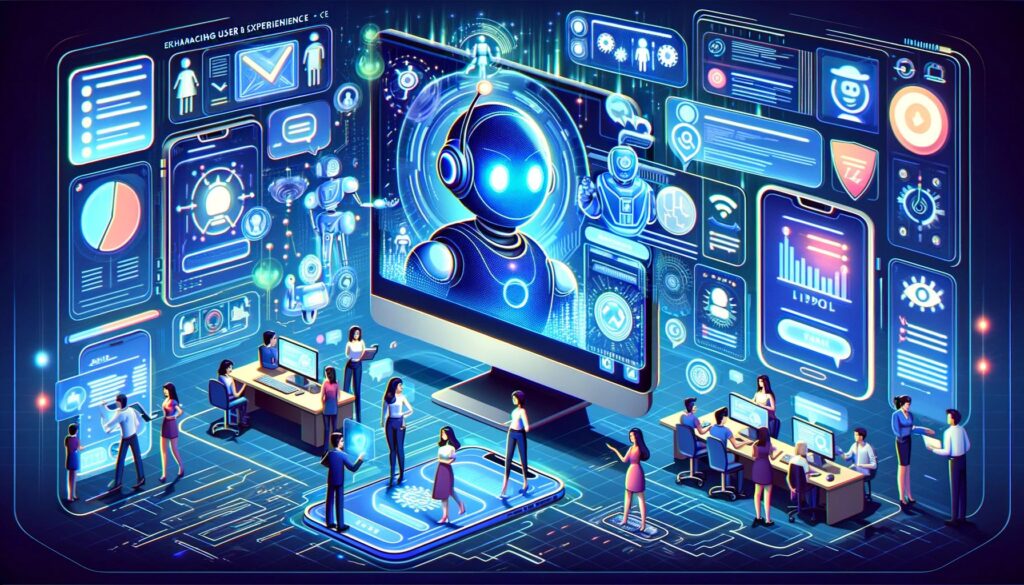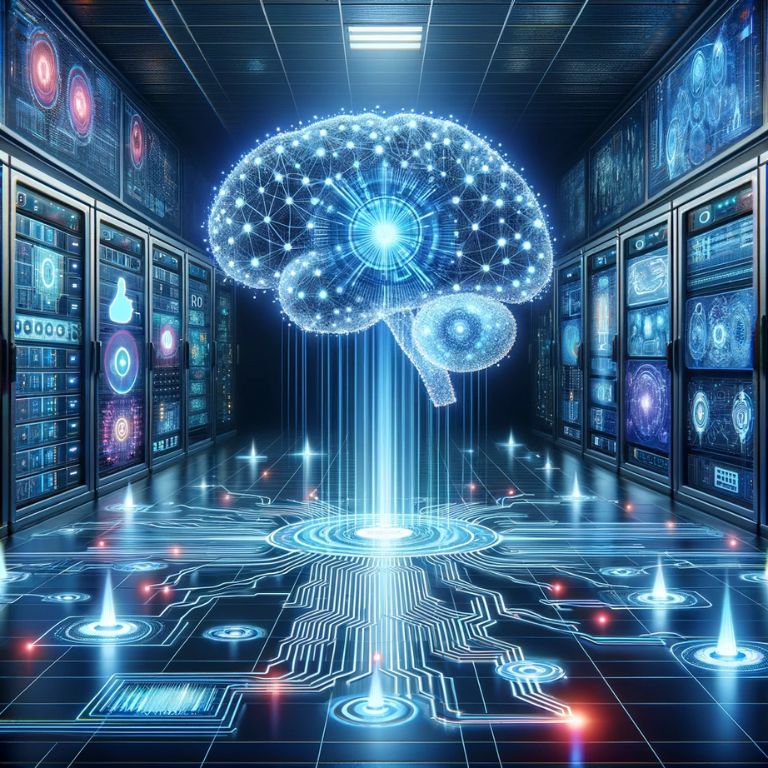Introduction to AI in Web Services
Artificial Intelligence (AI) is revolutionizing web services, transitioning from simple automation to creating systems that learn and adapt. AI enhances user experiences by personalizing interactions and streamlines development by automating tasks and optimizing workflows. As user expectations for seamless, intuitive online interactions grow, AI is pivotal in meeting these demands with its ability to understand and respond to user behavior. This integration marks a shift towards dynamic, intelligent web platforms, setting the stage for advanced developments in the field. The potential of AI in web services is vast, with its full impact just beginning to unfold.
Using Artificial Design Intelligence (ADI) in Web Services
Artificial Design Intelligence (ADI) is at the forefront of a transformative shift in web services, bringing unprecedented efficiency and creativity to the field of web design and development.
Understanding ADI’s Role in Web Development
Artificial Design Intelligence (ADI) represents a significant leap in web development. It leverages machine learning and advanced algorithms to automate and refine design processes, elevating both efficiency and user engagement.
How ADI Enhances Web Design
ADI analyzes large datasets to identify design patterns and preferences. This data-driven approach enables ADI tools to generate tailored designs, transforming the traditional design process by:
- Automating Repetitive Tasks: ADI significantly reduces manual effort by automating tasks like image resizing and layout configurations.
- Ensuring Consistency and Accuracy: By automating design elements, ADI maintains a high level of consistency across web pages, enhancing the overall look and feel.
Practical Applications of ADI
In the realm of web services, ADI can be applied in various innovative ways:
- Template Selection and Customization: ADI suggests and customizes website templates to fit the specific needs of different industries and content types.
- Responsive Design Creation: It ensures websites are visually appealing and functional across all devices, a crucial aspect of modern web design.
- User Experience Optimization: ADI analyzes user interactions to continually refine and improve the user interface and overall website experience.
AI-Driven Coding and Development in Web Services
The advent of Artificial Intelligence (AI) in coding and web development is reshaping the construction, maintenance, and enhancement of web services. This section delves into how AI-driven coding not only streamlines processes but also augments developer capabilities and fosters advanced, efficient, and secure web applications.
Enhancing Code Generation with AI
AI’s role in code generation is transformative, leveraging algorithms to interpret design mockups and user requirements swiftly. This automated code production significantly accelerates development timelines and diminishes human error. For example, tools like Bootstrap Shuffle and Sketch2Code convert designs into functional code rapidly, exemplifying AI’s efficiency in turning conceptual designs into tangible solutions.
Advanced Contextual Code Suggestions and Error Detection
AI’s capacity to provide real-time, contextual code suggestions and detect errors is a game-changer. IntelliSense by Microsoft and other similar AI tools understand the developer’s intent and offer code completion suggestions that align with the written code’s context, enhancing code quality and efficiency. Meanwhile, AI-powered platforms like DeepCode and CodeAI scrutinize the code for bugs and vulnerabilities, suggesting optimizations and security enhancements, thereby bolstering the overall integrity and reliability of web applications.
Optimizing Performance and Security through AI
AI extends its utility beyond code generation and maintenance to performance optimization and security enhancement. Tools like Google’s Closure Compiler analyze and optimize the code to improve loading times and efficiency without compromising functionality. On the security front, AI employs sophisticated pattern recognition and anomaly detection to identify and mitigate potential threats preemptively, utilizing platforms like CodeScan and Kiuwan to fortify web services against vulnerabilities.
Revolutionizing the Developer Workflow
The integration of AI in web development revolutionizes the developer workflow. By automating mundane tasks, developers are liberated to focus on more complex, innovative aspects of development. This not only boosts productivity but also fosters a culture of creativity and experimentation, driving the development of more sophisticated web services.
Navigating Challenges and Embracing Future Developments
Despite its numerous benefits, AI-driven development presents challenges. A heavy reliance on AI necessitates a careful balance to ensure alignment with the developer’s vision and adherence to quality standards. Moreover, as AI tools evolve, developers must continually update their skills to effectively collaborate with these advanced systems.
Enhancing User Experience with Chatbots

Chatbots powered by Artificial Intelligence (AI) have become integral components of web services, reshaping the way businesses interact with their users. These intelligent conversational agents offer a personalized and efficient means of engagement, significantly enhancing the overall user experience.
The Rise of AI-Driven Chatbots
AI-driven chatbots have gained prominence due to their ability to provide immediate and relevant support, making interactions with web services smoother and more user-centric. They are employed across various industries, from e-commerce and customer support to healthcare and finance.
Personalization and User Engagement
One of the key strengths of AI-driven chatbots lies in their personalization capabilities. These chatbots analyze user data and behavior to tailor responses and recommendations, creating a personalized experience for each user. For instance, an e-commerce website can use chatbots to recommend products based on a user’s browsing and purchase history, enhancing the likelihood of conversions.
24/7 Availability and Instant Responses
Unlike human agents, chatbots are available 24/7, ensuring that users can seek assistance or information at any time. This round-the-clock availability is particularly valuable for global businesses with diverse customer bases in different time zones.
Efficient Issue Resolution
AI-powered chatbots excel in issue resolution. They can efficiently handle common user queries, troubleshoot technical issues, and guide users through processes, reducing the need for human intervention. This not only saves time but also ensures consistency in support.
Natural Language Processing (NLP) and Multilingual Support
Advancements in Natural Language Processing (NLP) have made chatbots more adept at understanding and responding to natural language queries. Furthermore, many chatbots offer multilingual support, enabling businesses to engage with a global audience seamlessly.
Evolving Beyond Text-Based Conversations
Chatbots are evolving beyond text-based interactions. Voice-activated chatbots, integrated with speech recognition technology, offer a hands-free and user-friendly experience. Additionally, chatbots with visual recognition capabilities can analyze images and offer relevant responses, further enriching user interactions.
The Evolution of Voice Search in Web Services
Voice search has emerged as a transformative force in web services, reshaping how users interact with digital platforms. Powered by Artificial Intelligence (AI), voice search offers a convenient, hands-free method of accessing information, making inquiries, and performing tasks online. This section explores the impact of voice search on web services and its implications for the future.
The Proliferation of Voice-Activated Devices
The rise of voice-activated devices like smartphones, smart speakers, and virtual assistants has fueled the adoption of voice search. Users now have the capability to initiate searches and interact with web services simply by speaking, eliminating the need for typing and providing a more natural and intuitive user experience.
The Role of Natural Language Processing (NLP)
Natural Language Processing (NLP), a subset of AI, plays a pivotal role in voice search. NLP algorithms enable devices and applications to understand and interpret spoken language, transforming it into actionable commands or search queries. This capability has made voice search more accessible to a wider audience, including those who may struggle with traditional text-based interfaces.
Enhancing User Convenience
Voice search enhances user convenience significantly. It allows users to perform tasks and access information while multitasking, driving, or in situations where manual interaction is impractical. Whether it’s searching for a recipe, checking the weather, or controlling smart home devices, voice search provides a hands-free and efficient alternative.
Voice Search in E-Commerce
E-commerce has witnessed a significant impact from voice search. Users can inquire about product details, check availability, and even make purchases through voice-activated devices. Businesses are optimizing their websites and product listings to align with voice search queries, ensuring they remain competitive in this evolving landscape.
Optimizing for Voice Search
Web services and businesses are increasingly focusing on optimizing their digital assets for voice search. This involves understanding user intent in voice queries and tailoring content to provide concise and relevant answers. Featured snippets, also known as “position zero” in search results, are highly coveted as they are often the source of voice search responses.
Data Privacy and Security in AI-Enhanced Web Services

As Artificial Intelligence (AI) takes center stage in web services, concerns surrounding data privacy and security have come to the forefront. This section delves into the critical aspects of safeguarding user data and maintaining robust security measures in the context of AI-enhanced web services.
Data Privacy Challenges
AI-driven web services often rely on vast datasets to train algorithms and provide personalized experiences. However, collecting and processing user data raises significant privacy concerns. Striking a balance between personalization and user privacy is crucial.
Transparency and Consent
Maintaining transparency in data collection and usage is paramount. Users should be informed about what data is being collected, how it will be used, and have the ability to provide informed consent. Clear privacy policies and user-friendly consent mechanisms are essential.
Data Minimization
Practicing data minimization, where only necessary user data is collected, reduces the risk of data breaches. AI algorithms should be designed to work with minimal personal information to protect user privacy.
Data Encryption
Encryption is a fundamental aspect of data security. All data, whether in transit or at rest, should be encrypted to prevent unauthorized access. Secure Socket Layer (SSL) and Transport Layer Security (TLS) protocols are commonly used to encrypt data in transit.
User Authentication and Authorization
Implementing robust user authentication and authorization mechanisms ensures that only authorized users can access sensitive data or perform specific actions within web services. Multi-factor authentication (MFA) adds an additional layer of security.
Regular Security Audits and Testing
Continuous security audits and penetration testing are essential to identify vulnerabilities and weaknesses in AI-driven web services. Regular assessments help in addressing security issues promptly.
Compliance with Data Protection Regulations
AI-driven web services must comply with data protection regulations such as the General Data Protection Regulation (GDPR) and the California Consumer Privacy Act (CCPA). Non-compliance can result in severe legal repercussions.
AI in Cybersecurity
AI itself plays a pivotal role in cybersecurity. AI-driven threat detection systems can identify and respond to security threats in real-time, enhancing overall security measures.
Ethical Considerations
Ethical considerations are integral to AI-driven web services. Avoiding bias in algorithms, ensuring fairness, and respecting user rights are ethical imperatives in AI development.
The Collaborative Future of AI and Human Expertise in Web Services
The collaborative synergy between Artificial Intelligence (AI) and human expertise is poised to define the future of web services. In this section, we explore how the integration of AI and human capabilities creates a powerful partnership that drives innovation, efficiency, and exceptional user experiences.
AI as an Augmentation Tool
AI is not a replacement for human expertise but rather an augmentation tool that empowers human professionals. It excels in handling repetitive tasks, data analysis, and automation, freeing up human experts to focus on more complex and creative aspects of web services.
Content Creation and Curation
AI-driven content generation tools are increasingly used to create and curate web content. These tools assist human content creators in producing high-quality, data-driven content at scale. They analyze user behavior and preferences to tailor content for specific audiences, ensuring relevance and engagement.
AI-Powered Analytics
AI-powered analytics tools provide actionable insights by processing vast amounts of data. Human analysts can then interpret these insights, make strategic decisions, and implement improvements in web services. The collaboration between AI and human analysts is invaluable for data-driven optimization.
Customer Support and Engagement
AI-driven chatbots and virtual assistants enhance customer support by providing instant responses to common queries. Human support agents are freed from routine tasks and can focus on more complex issues, offering personalized assistance and improving overall customer satisfaction.
Design and User Experience
AI tools, such as Artificial Design Intelligence (ADI), assist designers in creating visually appealing and user-friendly web interfaces. Human designers provide the creative vision, while AI automates repetitive design tasks, ensuring consistency and efficiency.
Continuous Learning and Improvement
AI systems learn and adapt over time based on user interactions and data analysis. Human expertise guides this learning process by defining goals, providing feedback, and refining AI algorithms to align with business objectives.
Ethical Considerations and Oversight
Human oversight is essential to ensure AI systems operate ethically and within legal boundaries. Human experts are responsible for setting ethical guidelines, addressing biases, and making decisions in situations where AI may fall short.
Conclusion
The future of web services is inextricably linked with Artificial Intelligence (AI). AI is reshaping web design, streamlining development, enhancing user support, and revolutionizing how users access information. It is pivotal in ensuring data privacy and security while fostering a collaborative synergy with human expertise. This partnership amplifies capabilities and drives innovation. As AI continues to evolve, promising even greater advancements, it is crucial for businesses to harness its potential ethically and securely. The future of web services lies in a harmonious partnership between AI and human expertise, creating exceptional digital experiences for users worldwide.




